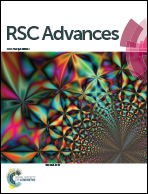Percolation and resistivity-temperature behaviours of carbon nanotube-carbon black hybrid loaded ultrahigh molecular weight polyethylene composites with segregated structures
Abstract
An ultrahigh molecular weight polyethylene (UHMWPE) composite containing carbon nanotube–carbon black (CNT–CB) hybrid was fabricated via a facile method, i.e., mechanical mixing plus hot compaction in order to obtain low-cost conductive polymer composites with balanced electrical properties. Optical microscope and scanning electron microscope observations indicate the formation of a typical segregated structure in the CNT–CB/UHMWPE composite, with the CNT–CB hybrid selectively located at the interfaces of UHMWPE granules. Compared to the single CNT loaded UHMWPE composite, the CNT–CB/UHMWPE segregated composite with a quarter replacement of CNT with CB shows only 8% decline in electrical conductivity, with the same filler content of 4 wt%, realizing a significant reduction in the material cost. More interestingly, the CNT–CB/UHMWPE composite presents 273% higher positive temperature resistivity intensity than that of CNT/UHMWPE composites, exhibiting strong sensitivity to ambient temperature. Our work demonstrates a novel strategy to fabricate low-cost and high-performance conductive polymer composites by the combination of hybrid fillers and a segregated structure.


 Please wait while we load your content...
Please wait while we load your content...